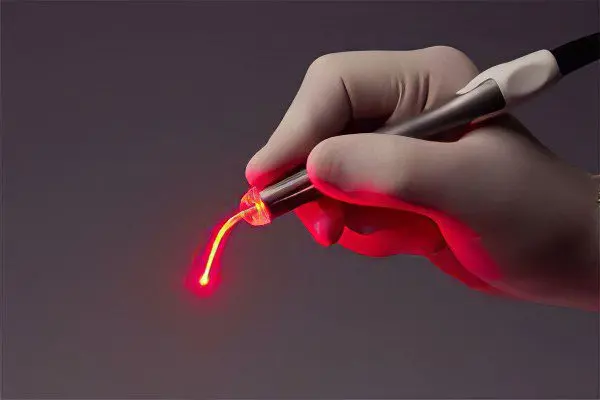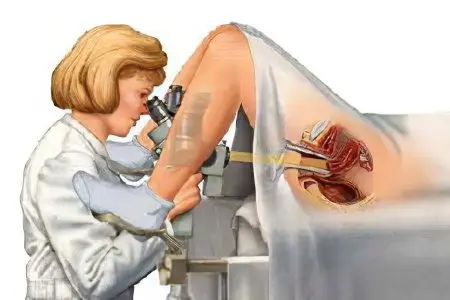Contents
- Methods of cauterization of cervical erosion
- How is burning done?
- Contraindications for cauterization
- What tests should be taken before cauterization of erosion?
- Consequences of cauterization of cervical erosion
- Popular questions and answers:
- What to do after cauterization of cervical erosion? Recommendations

Cauterization of cervical erosion – this is the general name for a group of therapeutic techniques, the purpose of which is to influence pseudo-erosion and completely eliminate it. Due to the fact that the disease is widespread and affects up to a third of all women on the planet, cauterization methods are constantly being improved and expanded. It is the destructive methods of influencing erosion that are most effective in terms of its treatment.
Most women use the term “cauterization”, meaning direct heating and burn formation on the epithelium. However, this use of the word is not entirely correct. For example, if a damaged area is exposed to nitrogen, then this is nothing more than freezing, and if erosion is eliminated with a laser, then its cells are simply evaporated. However, all these methods in everyday life are referred to as cauterization.
In addition, only pseudo-erosion is cauterized – but not true and not innate. Pseudo-erosion is formed as a result of a violation of the healing processes of true erosion, when a certain part of the stratified squamous epithelium is replaced by a cylindrical one that “left” the cervical canal. As a result, a site is formed that differs both in structure and in appearance. It is this zone of ectopia that must be subjected to destruction.
Methods of cauterization of cervical erosion
Modern clinical gynecology has a set of methods for the physical elimination of the pathological process.
Among them are:
Diathermocoagulation – a method of treatment with current. One of the outdated and most traumatic ways to get rid of erosion.
Cryodestruction – a method of getting rid of erosion with the help of nitrogen. This is a more gentle way to remove erosion by freezing pathological cells and their subsequent destruction.
Laser vaporization – a method of getting rid of pathology using a laser. A fairly painless and effective way to remove erosion, while having high efficiency.
Radio wave coagulation – a method of cauterization of erosion using radio waves. One of the most promising and progressive methods of healing damaged areas.
Argon plasma ablation method — elimination of erosion using argon. It is performed using special devices in which argon is ionized by high-frequency currents and the plasma beam accurately affects the eroded area.
Electroconization, used to treat severe dysplasia, allows you to get rid of atypical cells even deep epithelial layers.
Ultrasound. Getting rid of the patient from erosion using ultrasound.
Chemical or drug cauterization. Most often, Solkovagin is used for this purpose, which causes tissue necrosis, the formation of a scab, followed by its replacement with a layer of new epithelium.
The choice of one or another method of treatment will depend on the condition of the woman, her age, the presence of concomitant diseases, etc.
Cauterization of cervical erosion with a laser

In order for the treatment of a damaged area with a laser to have a positive effect, a thorough preliminary examination is necessary. Indeed, in one case, low-intensity exposure will be effective, in the other, on the contrary, high-intensity, and in the third – carbon dioxide. In this regard, the area of the affected area and the duration of the existence of erosion are significant. The “older” and larger the pathology, the more intense the impact will be. In addition, a woman should not suffer from an infectious disease of the genital area. If so, then pre-treatment is needed.
In medicine, the concept of cauterization of the cervix with a laser does not exist, doctors call this procedure “laser vaporization”. It is carried out in an outpatient setting, does not require anesthesia, even local. The essence of the procedure is as follows: the doctor outlines the boundaries to be processed (a laser is used for this, it acts like a pencil), then systematic evaporation begins. Evaporation of atypical cells begins from the cervical canal, and ends at a pre-drawn border (for the purpose of safety net, a healthy zone is captured within 2 mm). The whole procedure takes no more than 7 minutes.
Benefits. The advantage of this treatment is that there is no risk of bleeding: the vessels immediately coagulate.
Nuances. A woman should know that large erosions cannot be cured at a time, up to 2-3 procedures may be required, the interval between which should be at least a month.
After cauterization. After the laser treatment is carried out, a woman may experience slight discharge for some time. They can be observed for no more than 3 weeks. Full recovery of the mucous membrane of the cervix occurs after 1,5 months. This method is suitable even for nulliparous women. Among the main contraindications: the period after childbirth, pregnancy, inflammation of the vagina, uterus or appendages, as well as malignant neoplasms.
Radio wave treatment of cervical erosion
Doctors dealing with the problem of eliminating the erosive process claim that it is this therapy that is the most effective and safe in comparison with other methods. This procedure is non-contact, low-traumatic and painless, does not cause bleeding, and possible complications are minimized. However, due to the fact that the method is quite new, it is not widely used.
Before performing the procedure, it is imperative to conduct a histological examination, pass a smear on the microflora, in order to identify venereal diseases.
Carry out therapy with radio waves in the first half of the menstrual cycle (the optimal period is from 5 to 10 days, after the onset of menstruation). This is due to the fact that the risks of complications are minimized, and the tissues themselves recover faster.
The essence of the procedure is that radio waves increase the temperature of the treated tissues by thermal action on the liquid inside the cells. It heats up and evaporates, and the vessels located around are coagulated. Direct exposure is carried out using an electrode, which emits waves. The device itself does not come into contact with the surface of the cervix. Most often, the Surgitron apparatus is used to perform the procedure. Due to such a gentle effect, after processing, no scab is formed, but a thin film is formed.
Anesthesia, as a rule, is not used, since the sensations that a woman experiences are comparable to mild pulling pains during menstruation. But if the threshold of her sensitivity to pain is too high, then it is advisable to apply local anesthesia. In parallel, existing adhesions or other defects on the cervix and cervical canal can be eliminated.
The recovery process most often does not exceed one month. A woman may be disturbed by minor discharge, which completely disappears after 10 days.
One session is enough for a complete cure. Radio wave coagulation is suitable for all women, including those who are planning a pregnancy in the near future. You can do this already a month later, after a scheduled visit to the gynecologist.
Of the recommendations after the procedure: renunciation of intimate life for 4 weeks, limitation of physical activity, a ban on swimming in open water, pools and baths. The only drawback of this progressive and safe method of removing erosion is the high cost of the procedure, as well as the lack of apparatus and specialists in municipal clinics.
Cauterization of cervical erosion by current

The most outdated method of eliminating erosion is to cauterize it with current. In medicine, this method of therapeutic action is called “diathermocoagulation”. Of the indisputable advantages, one can single out its ubiquitous availability and high efficiency. That is why it has not yet been completely abandoned.
Before conducting current treatment, it is necessary to sanitize the vagina and eliminate any infectious and inflammatory process.
The essence of the method is that the electrode, which emits current discharges, touches the affected surface pointwise until all erosion is covered with a scab. As a result, a wound is formed at this place, which bleeds, but is covered with a crust from above. Two months later, it epithelializes. The scab itself goes away in about 10-12 days. Since there is no instant coagulation of the vessels during the procedure, the woman has spotting bleeding during the recovery period.
In addition, a serious drawback of this method is the formation of a rough scar from the connective tissue. This may further negatively affect the course of childbirth. That is why this method of cauterization is not recommended for nulliparous girls.
Cauterization of cervical erosion with nitrogen
This method is based on cold treatment. Damaged tissues are exposed to transformed liquid nitrogen by means of a cryoprobe. The procedure is single, most often it does not take more than 5 minutes. Pathological cells crystallize and then die. After an average of 2-3 months, they are replaced by healthy ones. The optimal time for the procedure is from the 7th to the 10th day of the menstrual cycle.
Contraindications include a large erosion surface – more than 3 cm, cervical injuries, fibroids, any infectious and inflammatory processes in the genital organs, as well as pregnancy and tumors.
The procedure is painless, but at the request of the patient, she can be given local anesthesia, as there is a slight burning sensation or slight tingling. This method is applicable in nulliparous women. Among other advantages – the speed of conducting on an outpatient basis, the absence of bleeding.
However, the method has some disadvantages: a long recovery process, the appearance of watery secretions, the inability to process deeply affected tissues. In addition, repeated therapy may be required.
Chemical coagulation method
The procedure is reduced to the treatment of the eroded surface with medications. If earlier doctors used mainly Vagotil, now it has been replaced by a more modern and effective remedy – Solkovagin.
During the procedure, the doctor, using a cotton swab, dries the damaged area. Another swab is thoroughly impregnated with the selected agent and the area with erosion is treated with it. The processing time is 3 minutes. Excess drug is removed with another dry cotton swab. For a more accurate application, the entire session takes place under the control of colposcopy.
The procedure is completely painless and does not even require local anesthesia. This method of treatment is suitable for a woman who has never given birth. However, this method is not used if the erosion is more than 1 cm in diameter. But due to the fact that the drugs act much softer than the physical methods of treatment, several procedures may be required for a complete cure.
How is burning done?

Any cauterization process is aimed at destroying pathological cells, which must subsequently be replaced by a healthy stratified squamous epithelium. As already mentioned, the term “cauterization” is not always correct. However, it is he who reflects the essence of any technique.
If we consider any procedure in stages, then it consists of a series of sequential actions:
A woman undergoes a complete diagnosis to detect any contraindications to a cauterization session.
If none are found, the patient comes to the doctor, most often in the first half of the menstrual cycle.
The treatment area is being prepared (its boundaries are determined, sometimes the surface is dried).
Erosion is affected in one way or another, destroying its cells.
In place of the treated surface, either a scab or a thin film is formed.
Within a few weeks, the scab falls off, and the damaged tissue is replaced with healthy tissue.
A scar is formed on the treated surface. However, modern medicine allows this unpleasant stage to be avoided.
The woman is recovering.
Contraindications for cauterization
In order to undergo the cauterization procedure by any of the above methods, you must make sure that there are no contraindications.
Among them are the following:
Any inflammatory processes of the genital area.
Presence of any sexually transmitted disease.
Any bleeding in the active phase.
Blood clotting disorders.
Malignant neoplasm of an eroded area.
Pregnancy, and sometimes lactation.
Persistent lochia and early postpartum period.
Decompensated diabetes mellitus.
Installed intrauterine device.
Performed caesarean section.
Carrying the human papillomavirus.
Certain psychiatric disorders, such as schizophrenia and seizure susceptibility.
Wearing a pacemaker (for some methods).
Exacerbation of chronic diseases.
In addition, some methods are not applicable for significant erosion.
What tests should be taken before cauterization of erosion?

Before starting treatment with this or that method, a woman will need to undergo a comprehensive diagnosis. It includes the delivery of tests, among which the following are mandatory:
Blood test for HIV.
Clinical blood test.
Blood chemistry.
Clinical analysis of urine.
Blood test for hepatitis.
A blood test to detect urogenital infections, including HPV. The most reliable in this regard is PCR analysis.
Taking a smear for oncocytology (Papanicolaou test) and flora.
The passage of an extended colposcopy, and if indicated, a biopsy.
If no deviations from the norm are found according to the results of these tests, then the woman will be sent for the cauterization procedure. If any sexual or other infections are detected, preliminary treatment is necessary.
Consequences of cauterization of cervical erosion
Although medicine has come a long way in terms of treating erosion, however, an ideal procedure that would not have any consequences for a woman’s body has not been found. Each method has its own advantages and disadvantages. Therefore, it is so important to make not only the right choice regarding the method of cauterization, but also to find a qualified specialist.
Among the possible consequences of cauterization of erosion, both immediate and distant symptoms are distinguished.
The closest, that is, those that may occur in the first 8 weeks after the procedure, include:
Exacerbation of inflammation of the fallopian tube or at the same time the fallopian tube and ovaries. Most often, the process is one-sided, although it can develop on both sides.
Bleeding with significant loss of blood (this complication does not include minor sanious discharge, which is the norm).
Menstrual disorders, in particular, the development of amenorrhea.
Among other consequences that occur two months after cauterization, more often than others are observed:
Complete scarring or stenosis of the cervical canal.
Scarring of the underlying layer, this complication has received the name “coagulated neck syndrome” in medicine.
Re-occurrence of erosion in the same place.
Endometriosis, which occurs against the background of a slow recovery of the epithelial layer of the cervix. If this did not happen by the beginning of the next menstruation, then the endometrial cells that have departed with blood can infiltrate an unhealed wound and form a focus of inflammation.
If we consider such consequences as minor pulling pains in the lower abdomen and discharge, then they, as a rule, are not classified as complications. This is due to the fact that the increase in secretions and their somewhat unusual nature is a natural physiological process of restoring the epithelium. They are observed to some extent after passing any method of cauterization. After all, even with the coagulation of blood vessels, at the bottom of an artificially formed pit, the production of damaged glands increases, which begin to produce a secret in large volumes.
Bloody secretions appear as a result of the fact that blood vessels are locally damaged. Also, blood can form where the scab does not quite correctly or incorrectly depart. However, such phenomena should pass quickly and on their own. Otherwise, you need to consult a doctor for help. It is also worth knowing that the more aggressive the cauterization method, the more abundant the discharge will be. This, first of all, concerns diathermocoagulation. The doctor is obliged to warn the patient about this in advance.
Popular questions and answers:

Does it hurt to do cauterization of cervical erosion? It is the question of the pain of the procedure that most often worries a woman. Fearing severe pain, many patients delay the start of treatment, harming their own body. This is not worth doing, since cauterization is an almost painless process. The fact is that the cervix has a negligible number of nerve endings. It is this fact that explains the fact that the disease has a mild clinical picture. Therefore, you should not be afraid of pain, especially if a woman has chosen one of the modern methods for cauterization. In addition, if the doctor sees increased anxiety or a sense of fear in the patient, he can offer her local anesthesia. Most often this is done to calm the patient, as well as during diathermocoagulation, in which there is direct contact with the damaged surface. As an anesthetic, most doctors give priority to lidocaine (the drug is either injected or used as a spray).
Is it possible to get pregnant after cauterization of cervical erosion? The erosion cauterization procedure is not an obstacle to subsequent conception. It is possible to get pregnant, however, it is worth waiting 1-2 months before starting to bear a child, since it is during this time that the tissues will fully recover and the doctor will be able to assess the success of the treatment. A fundamentally important point for women who have not yet given birth is a competent definition with the choice of a method for cauterization. Diathermocoagulation is categorically not suitable for such patients, as it causes the formation of a scar, which often complicates the process of childbirth. Therefore, it is better to use more gentle ways to get rid of pathology.
On what day of the menstrual cycle is it better to cauterize erosion? Doctors unanimously agree that the optimal time for the procedure is either the 5th or 6th day of the cycle. Thus, it will be possible to achieve maximum healing of the epithelial tissue until the onset of the next menstruation. If it was not possible to get rid of the pathology on the second day after the end of menstruation, then the maximum possible period is 9-10 days. Although in this case it is advisable to consult a doctor and, if possible, reschedule the session to the next month.
Childbirth after cauterization of cervical erosion. Most of both women who have given birth and those who have not given birth are worried about how cauterization can affect the delivery process in the future. These fears come from the past, when diathermocoagulation of blood vessels was the only way to eliminate the pathology. It is as a result of such a session that a scar remains on the neck, which threatens to break when the child passes through the natural birth canal. However, modern methods of treatment make it possible to avoid such problems, since they are: non-contact, the doctor controls the depth of exposure to epithelial tissues, carefully monitors the boundaries of the treated surface. As a result, on the cervix that has recovered after the procedure, there are no visible traces of the fact that cauterization was performed. This means that modern methods of treatment do not have any effect on the process of childbirth, since it is more dangerous to conceive a child with an “acting” ectopia, especially of inflammatory origin.
Can erosion reappear after cauterization? The defect may occur in a woman again, after the treatment.
But without any reason, it does not occur:
Firstly, the introduction of an aggressive sexual infection, douching with solutions that are not suitable for this purpose, injuries sustained during labor or during an abortion, etc., can provoke the appearance of erosion.
Secondly, if the factor that provoked the appearance of the previous erosion was diagnosed incorrectly or was not completely eliminated. It turns out that the defect was burned, but its “root” was not eliminated. As a result, after some time it will reappear.
Thirdly, the patient should know that procedures such as removal of erosion with nitrogen or chemical coagulation are quite gentle. This means that several sessions will be required. After the first therapeutic effect, erosion will not be removed, but this does not mean that it has arisen again.
Sex after cauterization of cervical erosion. After the problem is eliminated, it is worthwhile to withstand a certain time period before having sexual intercourse again.
First of all, it depends on which method of eliminating the defect was chosen, since the epithelium will recover at different rates:
If a woman has undergone complete cryodestruction, then the optimal time for the onset of sexual relations is 6 weeks later.
When the patient underwent laser vaporization, it will be possible to have sex not earlier than in a month, but it is better to wait 2 months.
If a choice was made in favor of radio wave surgery, then tissue restoration occurs on average after 1,5 months, it is for this period that intimate life should be postponed.
The longest period of sexual abstinence will be in a woman who has gone through diathermocoagulation – it is 2,5 months.
When the cervix has been treated with Solkovagin, you will have to wait at least a week, and the maximum safe period is 3 weeks.
Doctors recommend: before starting sexual relations, be sure to come for an examination and make sure that the cervix has fully recovered. If this does not happen, then sexual rest can be extended for a longer period.
Bloody discharge after cauterization of erosion. After the procedure, a woman may experience various kinds of discharge. Mostly they are with blood impurities.
However, their nature depends on the stage of healing:
Bloody issues Normally, they can disturb a woman for up to 10 days. They may be slightly pinkish, or they may have a more saturated hue. After the specified time, the discharge should become mucous, thicker, appear in a smaller volume. The appearance of blood is explained by the fact that some vessels burst immediately after the procedure or as the scab is discharged.
pinkish discharge can change their color to a more saturated brown, but normally a week after that, they should completely stop.
The normal recovery cycle of the cervical epithelium is as follows: first, watery discharge appears, with slight blood impurities, they are replaced by thicker pink discharge, which is subsequently replaced by brown and scanty. In addition, in each of these types, a woman can observe small clots – dark pieces. They, as a rule, are particles of an outgoing scab.
Light bleeding in a woman who has undergone cauterization may open between days 8 and 21. It is associated with the complete discharge of the scab and should be completed within a couple of hours. You should not worry about this, as this is a natural physiological healing process. It is necessary to consult a doctor when there is an abundant discharge of blood, an increase in body temperature, severe pain in the abdomen and other alarming symptoms. The following norm serves as a guideline: the discharge should not exceed the volumes that a woman is used to losing during menstruation.
Unpleasant smell after cauterization of cervical erosion. An unpleasant smell after the procedure is not the norm. It may indicate insufficient or improper intimate hygiene. If a woman follows all the rules and recommendations of a doctor for caring for herself, and an unpleasant smell continues to haunt, then this may indicate an infection. You should definitely visit your doctor and take a smear from the vagina to determine the pathogenic microflora. The reason for an urgent trip to the doctor is purulent, or having a greenish tinge of discharge. These signs unequivocally point to an inflammatory process that has joined.
How long does cervical erosion heal after cauterization? First of all, the recovery time after cauterization depends on how it was performed. The shortest recovery period in a woman is observed after chemical coagulation. As a rule, three weeks are enough for the epithelial tissues of the cervix to completely regenerate. The longest recovery period will have to go through a woman who underwent diathermocoagulation. The treated area will fully recover after 2,5, and sometimes three months. The average recovery time is from 4 to 8 weeks, subject to the implementation of medical recommendations and without the addition of complications.
Is it possible to play sports after cauterization of erosion? If before the moment a woman had to go through cauterization, she went in for sports, then after a week she can resume training. However, they should consist of warm-up exercises and take place at a reduced intensity. If you experience pain or increased discharge, you will need to abandon physical activity for a month. It is for this period that doctors recommend to refrain from sports. During this time, the scab leaves and the cervix is uXNUMXbuXNUMXbpartially restored. Doctors make exceptions only for professional athletes who may lose shape. This limitation is explained by the fact that increased physical activity can provoke serious bleeding from vessels injured after the procedure.
What to do after cauterization of cervical erosion? Recommendations

The procedure for cauterizing an ectopia is a serious intervention in a woman’s body, so she must follow all medical recommendations. This will make the recovery process as fast as possible and minimize the risk of possible complications.
Among the many recommendations, it is important to adhere to the following:
If possible, sexual rest should be observed during the first one and a half months after the cauterization session. Return to intimate life is possible after examination of the cervix by a gynecologist.
Under the ban any exhausting physical activity. A woman should not lift weights, as this increases the risk of complications.
Do not swim in open water. You should also refuse to visit the baths, saunas, steam rooms and baths. All hygiene procedures must be carried out under running water or under a shower.
As an adjunctive therapy, a woman can use topical treatment. The use of tampons with medicinal formulations (sea buckthorn oil or levomekol ointment) contributes to the fact that the scab softens faster and more easily leaves. In addition, it is an excellent prevention of its incorrect separation, which means it prevents the development of bleeding.
Pregnancy should not be planned immediately after the procedure. A woman needs to wait at least a month until the next menstrual cycle ends. In addition, it is important to make sure that there are no long-term complications after the intervention.
In addition, in the first month after the cauterization session, unless absolutely necessary, you should not undergo an ultrasound scan, for which a vaginal sensor is used.
It is important to observe the rules of intimate hygiene. Gaskets should be changed as they get dirty. Wearing the same sanitary napkin for more than 3 hours promotes the development of bacterial microflora, and therefore increases the risk of infection. Underwear should be made from natural fabrics, tampons should be discarded.
During the first two months, it is worth giving up bad habits, since, for example, smoking and alcohol contribute to the occurrence of vasospasm and their expansion. This, in turn, leads to an increased risk of bleeding.
Do not use any folk remedies to accelerate the healing of the treated surface. This is especially true for douching with various solutions. Thus, it is possible to introduce an infection, cause a burn or injury, contribute to the development of bleeding, etc. Any manipulations are possible only after consulting with your doctor.
Compliance with these simple recommendations will allow you to avoid complications and recover in the shortest possible time. Erosion is a very common problem among women. Most of them successfully passed the cauterization procedure and forgot about the defect of the cervix forever. Therefore, if the doctor recommends going for such treatment, you should not refuse it. The main thing is to make the right choice of the method of cauterization.









